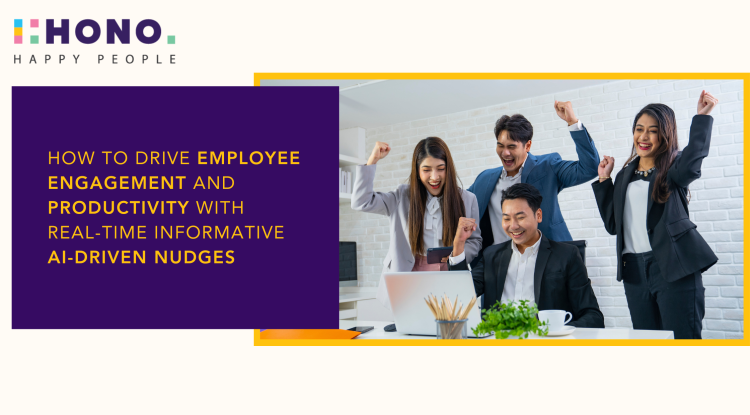
How to Drive Employee Engagement and Productivity with Real-Time Informative AI-driven nudges
05 Oct, 2022 |

In today's fast-paced business environment, employee engagement and productivity are critical to the success of any organization. Engaged and productive employees are more likely to stay with the company, deliver high-quality work, and contribute to the growth of the business. However, maintaining high levels of engagement and productivity can be a challenging task for managers, especially with the distractions and disruptions of the modern workplace.
One solution to this challenge is the use of real-time informative nudges to encourage employees to stay on track and focused on their work. Nudges are small, subtle prompts that influence behavior without being intrusive or coercive. By leveraging artificial intelligence (AI) and data analytics, managers can provide real-time nudges that help employees make better decisions and stay productive.
So, how can AI-driven nudges transform an operation's performance? Let's explore some key strategies that organizations can use to drive employee engagement and productivity through the power of informative nudges.

Personalize the nudges
The first step to using informative nudges effectively is to make them personalized to each employee's needs and preferences. By analyzing employee data such as work patterns, habits, and preferences, managers can create personalized nudges that resonate with individual employees.
For example, if an employee tends to procrastinate on a specific task, a personalized nudge can be designed to remind them of the importance of the task and the consequences of missing the deadline. This type of personalized nudge is more likely to be effective than a generic reminder that does not take into account the employee's specific behavior patterns.
Focus on positive reinforcement
Positive reinforcement is a powerful tool for driving engagement and productivity. By providing positive feedback and rewards for good performance, managers can motivate employees to continue working at a high level.
Informative nudges can be used to provide positive reinforcement in real-time. For example, if an employee completes a task ahead of schedule, a nudge can be sent congratulating them on their achievement and encouraging them to continue the good work. This type of positive reinforcement can be an effective way to build employee confidence and increase engagement and productivity.
Use nudges for learning and development
Another way to use informative nudges is to support employee learning and development. By providing timely reminders and tips, managers can help employees stay up to date with the latest industry trends and best practices.
For example, a nudge can be sent to remind an employee about an upcoming training session or to encourage them to read an article on a specific topic. By using nudges in this way, managers can help employees improve their skills and knowledge, leading to increased productivity and job satisfaction.
Provide real-time feedback
Real-time feedback is an essential element of employee engagement and productivity. By providing timely feedback, managers can help employees stay on track and make continuous improvements in their work.
Informative nudges can be used to provide real-time feedback on specific tasks or projects. For example, a nudge can be sent to alert an employee to a mistake they made in a document or to remind them to double-check a critical detail. This type of real-time feedback can be an effective way to improve the quality of work and increase productivity.
Use gamification
Gamification is a fun and engaging way to drive employee engagement and productivity. By turning work tasks into games or challenges, managers can motivate employees to work harder and achieve better results.
Informative nudges can be used to support gamification initiatives by providing real-time updates on progress and achievements. For example, a nudge can be sent to congratulate an employee on reaching a specific milestone or to encourage them to keep working towards a particular goal. By using informative nudges in this way, managers can make work more fun and engaging, leading to increased productivity and job satisfaction.
In conclusion, the use of AI-driven informative nudges can have a significant impact on employee engagement and productivity. By personalizing the nudges, focusing on positive reinforcement, supporting learning and development, providing real-time feedback, and using gamification, managers can create a more supportive and engaging work environment. These strategies can help employees stay on track, make better decisions, and ultimately contribute to the growth and success of the organization. With the help of AI and data analytics, informative nudges can be tailored to the individual needs and preferences of each employee, making them more effective and impactful.
HONO A full-fledged conversational HRMS System Provides Real-Time Nudges to Enhance Employee Engagement. HONO uses AI-driven nudges to provide real-time feedback and guidance to employees. HONO can help to improve communication and collaboration between employees and managers. Hono leverages intelligent nudges, predictive analytics, and autonomous actions to help organizations streamline their HR processes. Additionally, the platform provides a single source of truth for all HR-related data, making it easier for businesses to manage their workforce effectively.
Want a conversational AI-based Full Suite HCM for your business? Try HONO



